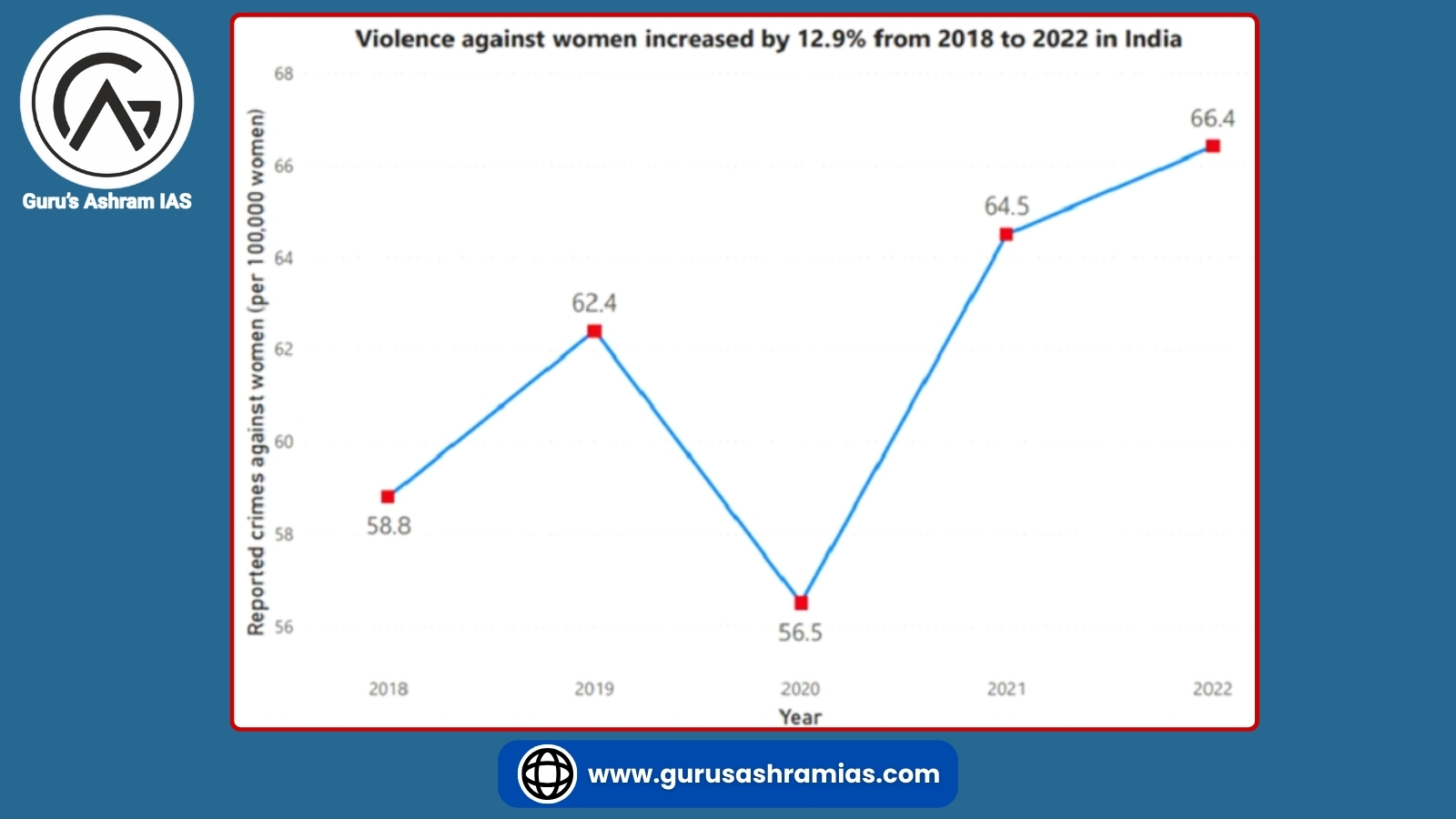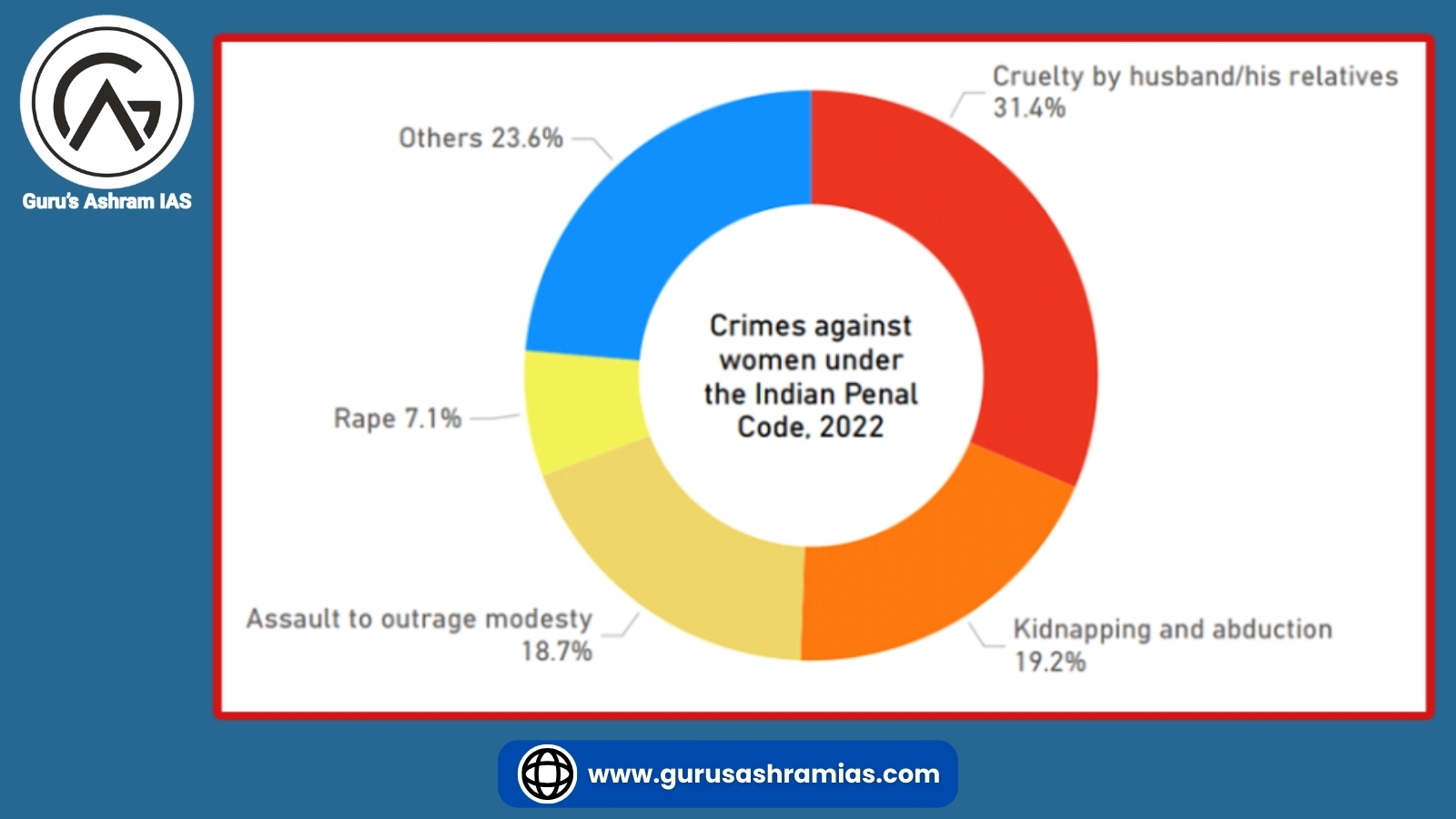Kolkata rape and murder case
- The recent rape and murder of a trainee doctor in Kolkata has raised concerns across the country about women’s safety, sparking protests by healthcare workers, who are now demanding a central law to protect them.
- Crimes against women continue despite stringent laws, underscoring the urgent need for comprehensive reforms.
The demands of health workers:
Central Security Act:
- The Indian Medical Association (IMA) is advocating the implementation of a nationwide law to ensure the safety of health professionals, similar to global examples such as the zero-tolerance policy of the United Kingdom’s National Health Service (NHS) and the United States’ hooliganism classification for assaults.
- Serious crimes in the U.S. are classified into categories based on their maximum prison sentences.
- The most serious category A offences carry a maximum sentence of life imprisonment or death penalty, while category E offences carry a maximum sentence of more than 1 year and less than 5 years.
Improved security measures:
- Better lighting, security guards and monitored security cameras in hospitals and medical centers.
- Ensure safe working and living conditions for doctors, including well-lit corridors and safe wards.
- Establishment of safety systems and emergency response mechanisms in health care centers.
The existing provisions:
Responsibilities of the State:
- Health and law and order are primarily state subjects, and the central government lacks centralised data on attacks on medical professionals.
- N.K. Singh, Chairman of the Fifteenth Finance Commission, suggested that health should be moved to the Concurrent List under the Constitution, as it is currently in the State List.
Order of the Ministry of Health and Family Welfare:
- It is mandatory to register an FIR within six hours of any violence against health workers.
National Medical Commission (NMC) directives:
- Medical colleges need to develop policies for safe working environment and timely reporting of incidents.
Central government’s response to the demands:
- The Health Ministry has said that the Kolkata incident falls within the ambit of existing legal provisions and the Central Protection Act is unnecessary as 26 states and Union Territories already have laws to protect healthcare workers.
- These laws treat violence against health workers, including doctors, nurses and paramedical staff, as cognizable and non-bailable.
Crime statistics on women’s safety in India:
Increasing Crime Rate:
- The National Crime Records Bureau (NCRB) recorded 445,256 cases of crime against women in the year 2022.
- Crimes against women increased by 12.9 per cent from 2018 to 2022.
- The Women and Men in India, 2023 report shows that violence against women has increased from 359,849 cases in 2017 to more than 445,000 in 2022, with 51 First Information Reports (FIRs) registered per hour with an average of 1,220 cases per day.
- The National Family Health Survey-5 found that nearly one-third of women aged 15-49 years in India have experienced some form of violence.
Types of offences:
- The most common crimes include cruelty by husband or in-laws (31.4 per cent), kidnapping (19.2 per cent), outraging modesty (18.7 per cent) and rape (7.1 per cent).
- These statistics underline the dangers that women face even in their own homes.
Cases of rape on the rise:
- The number of reported rapes has remained high, apart from a decline during the COVID-19 pandemic in 2020.
- Attacks reached nearly 39,000 in the year 2016. As of 2018, one report of female rape was reported every 15 minutes across the country, highlighting the alarming frequency of these crimes.
- More than 31,000 rape cases were reported in the year 2022, which shows the pervasive seriousness of the issue.
- Despite stricter laws, conviction rates for rape have been low, with rates fluctuating between 27%-28% from 2018 to 2022.
The impact of the pandemic:
- The COVID-19 pandemic has led to an increase in violence against women, with the crime rate increasing from 56.5 per 100,000 women in 2020 to 64.5 in 2021. This has been exacerbated by factors such as economic stress, social isolation and reverse migration.
Harassment in the workplace:
- Despite the enactment of Protection of Women from Sexual Harassment (Prevention, Prohibition and Redressal) Act, 2013, sexual harassment at workplace continues to be a concern with cases increasing from 402 in 2018 to 422 in 2022.
- However, there has been under-reporting of these numbers, potentially due to social biases and fear of repercussions.
The Women’s Safety Index:
- According to the Georgetown Institute’s Women’s Peace and Security Index-2023, India scored 0.595 out of 1, bringing its ranking to 128 out of 177 countries in terms of women’s inclusion, justice and security.
- The index also states that India is among the top 10 worst countries for political violence targeting women in the year 2022.
India’s initiatives related to women’s safety:
The law:
The international convention:
- Major international conventions, including the Convention on the Elimination of All Forms of Discrimination against Women (CEDAW), were ratified by India in 1993.
- India also supported the Mexico Plan of Action (1975), which aims to promote gender equality and eliminate gender discrimination completely.
The Immoral Traffic (Prevention) Act, 1956:
- It prohibits commercial sex workers and human trafficking for the purpose of prostitution.
Indecent Representation of Women Act, 1986:
- It prohibits indecent depiction of women in advertisements and publications.
The National Policy for the Empowerment of Women (2001):
- Aims to provide mechanisms for promotion and empowerment of women, prevention and prevention of violence against women, support and action.
Eleventh Five Year Plan (2007-2012):
- Violence against Women (VAW) was acknowledged as a major issue, with focus on domestic violence and rape.
Protection of Women from Domestic Violence Act, 2005:
- The victims of domestic violence are helped including shelter and medical facilities with mandatory protection officers.
The Sexual Harassment of Women at Workplace (Prevention, Prohibition and Redressal) (POSH) Act, 2013:
- The POSH Act deals with sexual harassment faced by women at the workplace, with the objective of ensuring a safe working environment.
- It defines sexual harassment as any physical, verbal, non-verbal conduct involving unwelcome physical contact or attempts, sexual demands or offers, sexual innuendo, showing pornography or pornography, or any other undesirable sexual or erotic gesture.
- The Act is based on the Vishakha guidelines established by the Supreme Court in the Vishakha and Others v. State of Rajasthan case, 1997, which deals with harassment at workplace.
- It is based on international norms such as Article 15 of the Indian Constitution and CEDAW.
The Criminal Law (Amendment) Act, 2013:
- Enacted for effective legal deterrence against sexual offences.
- Further, the Criminal Law (Amendment) Act, 2018 was enacted to prescribe even more stringent penal provisions including death penalty in case of rape of a girl under 12 years of age.
Jawaharlal Nehru National Urban Renewal Mission (JNNURM):
- Recommends inclusion of gender considerations in urban development to enhance safety of women.
The Protection of Children from Sexual Offences (POCSO) Act, 2012:
- Protects children from sexual offences, provides legal framework for their protection and ensures stringent punishment for offenders.
Strategies and Measures:
Save the girl child education plan:
- The scheme focuses on preventing gender discrimination and ensuring survival, protection and education of the girl child.
Ujjwala Yojana:
- It aims to prevent child trafficking as well as rescue and rehabilitate victims of commercial sexual exploitation.
Nirbhaya Fund:
- It aims to support initiatives for women’s safety, including setting up emergency response systems and improving public infrastructure.
Initiatives of the Ministry of Women and Child Development:
- Schemes like Swadhar Grih Yojana are aimed at providing short-term housing for women in difficult circumstances and conducting awareness programmes for them.
Women Safety in Trains:
- 182 Safety Helplines, CCTV cameras in ladies’ compartments and launch of ‘R-Mitra’ Mobile App for emergencies.
Safety of women tourists:
- These measures include ‘Incredible India Helpline’, Code of Conduct for Safe Tourism and directions to State Governments to ensure safe environment for tourists.
Safety of women in the metro:
- The Delhi Metro Rail Corporation (DMRC) has kept dedicated Central Industrial Security Force personnel for security along with special coaches and reserved seats for women.
Universal Women Helpline (Phone Sahayata) Scheme:
- It focuses on providing 24-hour emergency and non-emergency response through publicised helplines.
The mobile app:
Suraksha app:
- Suraksha is designed to provide quick and easy ways for women to connect with the police and send their location in case of an emergency.
Amrita Personal Security System (APSS):
- It is an effective tool in maintaining communication with family and police.
VithU:
- This app sends alerts to the people in the contact list in case of an emergency.
Laws and regulations not enough for women’s safety:
The lack of implementation:
- Strict laws enacted after the 2012 Nirbhaya case (such as the Criminal Law (Amendment) Act, 2013) have not been implemented in various areas and police jurisdictions.
- Implementation of regulations such as setting up of Internal Complaints Committees (ICCs) in the respective organizations remains inadequate.
- Additionally, in 2018, the Securities and Exchange Board of India (SEBI) required listed companies to report cases of sexual harassment annually, but this has not been effectively implemented.
Systemic issues:
- Corruption in law enforcement systems leads to laxity in efforts to reduce crimes against women.
- Many incidents of violence go unreported due to fear of reprisals, lack of faith in law and order, or the ineffectiveness of the legal process.
Cultural and social norms:
- Conservative social attitudes and norms weaken their legal protection. As a result, violence against women in some communities may be considered normal or not taken seriously.
- Women may be discouraged from reporting crimes or seeking help for fear of stereotypical cultural attitudes and stigma.
Legal Challenges:
- Victims often must give too much evidence to get justice, which can reduce the conviction rate. Due to legal complications, there is delay in getting justice to the victims.
- The judicial process being cumbersome may lead to delay in getting justice to the victims. It can also discourage victims from reporting crimes.
Economic dependency:
- Economic factors can also play an important role in this. Women who are financially dependent on abusers may find it difficult to break off relationships despite legal protections.
The resistance to change:
- Resistance to reform by institutions and policymakers can hinder the improvement of laws and regulations.
- Legal frameworks are not sufficiently developed to accommodate emerging forms of violence or changing social attitudes.
Lack of awareness and education:
- Women often have limited knowledge about their legal rights and available support services. This lack of information can be a barrier for women in accessing justice and assistance.
International approach to promote women’s safety:
Major international initiatives:
International Day for the Elimination of Violence against Women:
- International Day for the Elimination of Violence against Women is observed every year on November 25 across the world to prevent violence against women.
UN Women Safe Cities and Safe Public Spaces for Women and Girls:
- It aims to create safe and inclusive public spaces for women and girls. It recognizes that public spaces are essential to women’s participation in society, but they can also be places of fear and oppression.
- It aims to integrate gender perspectives into security strategies, develop tools to combat violence against women and promote women’s participation in urban planning.
Gender Inclusive Cities Programme:
- It is funded by the United Nations Trust Fund in support of action to end violence against women.
- The initiative aims to improve women’s safety in cities such as Dar-es-Salaam, Delhi, Rosario and Petrozavodsk by promoting equal access to public spaces.
- The United Nations Development Fund for Women (UNIFEM)
- UNIFEM provides financial and technical assistance to promote gender equality and women’s empowerment.
The Countries perspective:
United Kingdom:
- The London Authority’s strategy tackles violence against women and girls by promoting safe transport teams, running awareness campaigns and increasing enforcement.
Latin America:
- Cities such as Bogotá have developed women-only security strategies such as metro cars and police stations.
Solution:
Nationwide Protection Act:
- Supporting a central protection act that reflects the UK’s zero-tolerance policy (protection from violence and threats of attacks).
- The Act should provide equal protection to all working professionals and ensure consistent and comprehensive protection throughout the country.
- Monitoring mechanism should be strengthened to ensure compliance of existing laws like PoSH Act, 2013. Regular audits and reports should be mandatory to monitor effectiveness and compliance.
Fast-track courts:
- As per the recommendation of Justice Verma Committee, punishment in serious cases like rape should be increased along with setting up of fast-track courts. The representation of women in the judiciary should be increased.
Local Security Measures:
- Implementation of specialized police units such as SHE teams to prevent and combat violence against women.
- SHE Teams is a division of the Telangana Police that works to enhance the safety of women. SHE Teams has successfully provided protection and support to women who have been sexually harassed for crimes ranging from online stalking to physical assault and violence.
Safe City Design:
- Integrating safety features into urban planning such as improved street lighting and safe public spaces.
Support system:
- Strengthen support system for victims including counselling services and legal aid. Ensuring that victims have access to resources without additional barriers.
Public Awareness Campaign:
- To launch a nationwide campaign to raise awareness on women’s rights, workplace safety and available legal remedies using media, educational institutions and community organizations.






